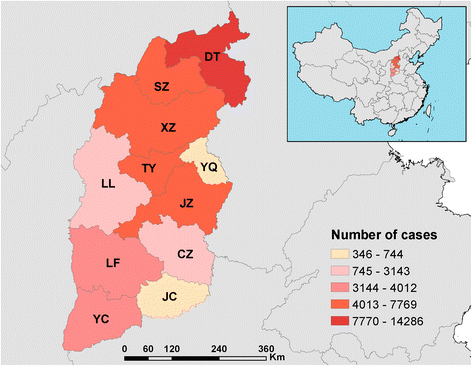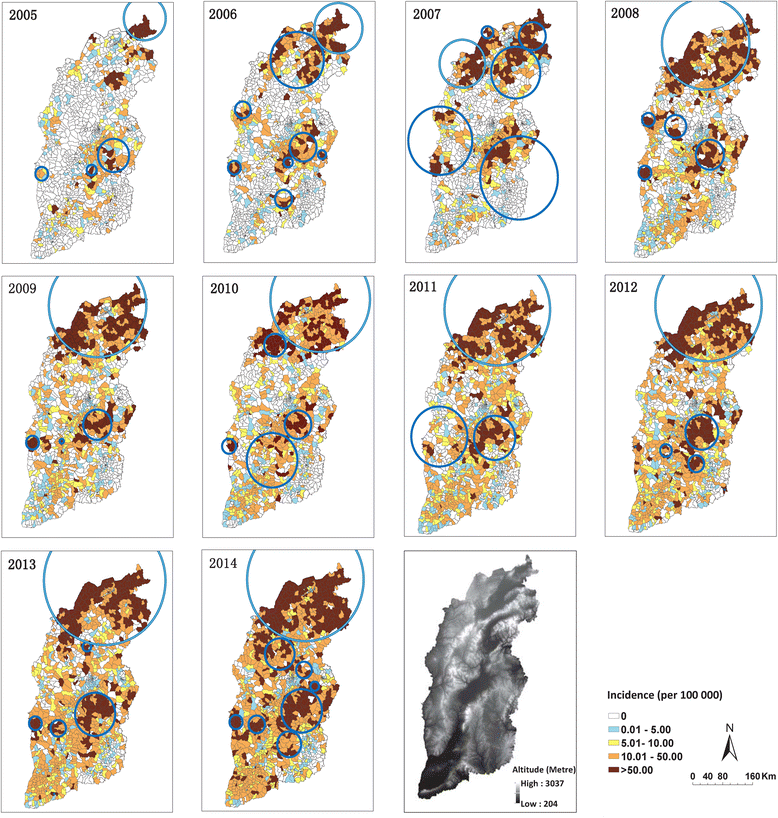Epidemic characteristics, high-risk townships and space-time clusters of human brucellosis in Shanxi Province of China, 2005-2014
- PMID: 27993134
- PMCID: PMC5165709
- DOI: 10.1186/s12879-016-2086-x
Epidemic characteristics, high-risk townships and space-time clusters of human brucellosis in Shanxi Province of China, 2005-2014
Abstract
Background: Brucellosis, one of the world's most important zoonosis, has been re-emerging in China. Shanxi Province, located in northern China, where husbandry development has been accelerated in recent years, has a rather high incidence of human brucellosis but drew little attention from the researchers. This study aimed to describe the changing epidemiology of human brucellosis in Shanxi Province from 2005 to 2014 and explore high-risk towns and space-time clusters for elucidating the necessity of decentralizing disease control resource to township level in epidemic regions, particularly in hotspot areas.
Methods: We extracted data from the Chinese National Notifiable Infectious Disease Reporting System to describe the incidence and spatiotemporal distribution of human brucellosis in Shanxi Province. Geographic information system was used to identify townships at high risk for the disease. Space-Time Scan Statistic was applied to detect the space-time clusters of human brucellosis during the past decade.
Results: From 2005 to 2014, a total of 50,002 cases of human brucellosis were recorded in Shanxi, with a male-to-female ratio of 3.9:1. The reported incidence rate increased dramatically from 7.0/100,000 in 2005 to 23.5/100,000 in 2014, with an average annual increase of 14.5%. There were still 33.8% cases delaying diagnosis in 2014. The proportion of the affected towns increased from 31.5% in 2005 to 82.5% in 2014. High-risk towns spread from the north to the center and then south of Shanxi Province, which were basins and adjacent highlands suitable for livestock cultivation. During the past decade, there were 55 space-time clusters of human brucellosis detected in high risk towns; the clusters could happen in any season. Some clusters' location maintained stable over time.
Conclusions: During the last decade, Shanxi province's human brucellosis epidemic had been aggravated and high-risk areas concentrated in some towns located in basins and adjacent highlands. Space-time clusters existed and some located steadily over time. Quite a few cases still missed timely diagnosis. Greater resources should be allocated and decentralized to mitigate the momentum of rise and improve the accessibility of prompt diagnosis treatment in the high-risk townships.
Keywords: Epidemiology; Geographic information system; High-risk areas; Human brucellosis; Poisson model; Shanxi province; Space-time scan statistic; Zoonosis.
Figures






References
-
- WHO/DFID-AHP. WHO/DFID-AHP meeting on control of zoonotic diseases:a route to poverty alleviation among livestock-keeping communities. 2005. http://www.who.int/zoonoses. Accessed 27 May 2016.
-
- Traxler RM, Guerra MA, Morrow MG, Haupt T, Morrison J, Saah JR, Smith CG, Williams C, Fleischauer AT, Lee PA, et al. Review of brucellosis cases from laboratory exposures in the United States in 2008 to 2011 and improved strategies for disease prevention. J Clin Microbiol. 2013;51(9):3132–3136. doi: 10.1128/JCM.00813-13. - DOI - PMC - PubMed
MeSH terms
LinkOut - more resources
Full Text Sources
Other Literature Sources
Miscellaneous

